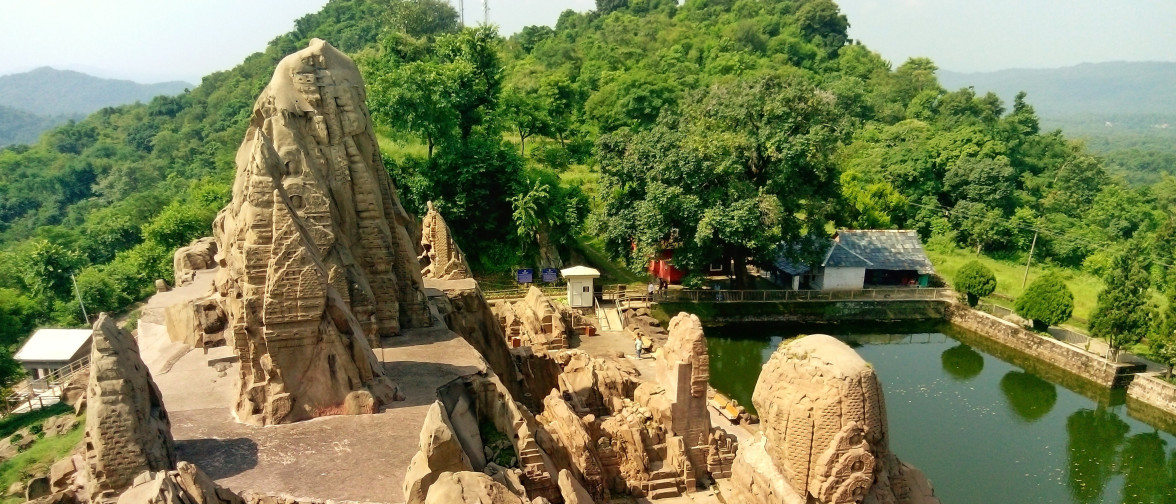
Stationed 1800 feet above the sea level, Pragpur is a gorgeous whistle town in the folds of the white mountains of Dhauladhar ranges. Pragpur is celebrated as the first Heritage village of India and rightly so. Came into being just 3 centuries ago, Pragpur is tightly holding on to its old-world charm with cobbled streets, muddy plastered and slate roofed houses, red brick shops and an ornate village tank. Most of the inhabitants of the village come from affluent Sood community, who having travelled to distant foreign lands build mansions, homes and other buildings in the different architectural styles they behold and were influenced by abroad. The quaint little village is dotted with lines houses each unique in itself but different in architecture from other. British, Italian, Portuguese, Kangra and Rajput styles of building are all visible here, the stateliest of all however is a two storey brick mansion – the Judge’s Court. Lala Rerumal’s Haveli and Lal Butel are two other remarkable palatial houses in the vicinity which commands attention from visitors. Preserving the same ethnic cultural heritage, Pragpur charms the visitors with its undisturbed settings and authenticity.
Summer: 20°C to 32°C
Winter: 6°C to 16°C
Monsoon: 23°C to 29°C
Judge’s Court
This two-storey red brick mansion is the most recognizable and iconic landmark of the heritage village. Beautifully and remarkably restored for 3 centuries, the palatial mansion is the ancestral home of the Lal family now transformed into a luxurious resort. Laden with apple and litchi orchards and decorated with colonial-era paintings and Victorian furniture, the mansion belonged to Sir Jai Lal, the 2nd Indian to hold the office of a High Court Judge during the Raj and hence the name – the Judge’s Court.
Kaleshwar Mahadev Temple
Dedicated to Lord Shiva, this temple 8 kilometers away from Paragpur Village is sot on the banks of river Beas. The presiding deity in the temple is believed to be Lord Rudra, the consort of Mata Chintapurni. The temple is the venue of annual Shivaratri festival, when devotees in scores of thousands visit the temple to pay their homage to the deity.
Haripur – Guler
Haripur & Guler are twin towns separated by a river. The marshlands and swamps created by the river are home to large variety of migratory birds. Haripur the birth place of famous Kangra miniature paintings was founded as a kingdom by Raja Hari Chand of Kangra in 15th century.
Jwalamukhi Temple, Pragpur or Jwala Devi Shrine
Jwalamukhi Temple, Pragpur or Jwala Devi Shrine is a one of the 51 Shakti pithams, it is the place where the tongue of goddess Sati fell. The temple is dedicated to Goddess in her Sakti avatar and does not houses an idol. The deity here manifests in the form of an eternal flame which has been burning incessantly since time immemorial without any source of fuel.
Pong Dam
Engineered on Beas River in 1975, the Dam serves the dual purposes of producing hydroelectricity and irrigation. Positioned on the base of Shivalik ranges, the dam is surrounded by stunning landscapes and lush green forests sheltering a bevy of exotic wildlife. The reservoir lake, Maharana Pratap Sagar is home to gamut of bird species and is declared a Bird Sanctuary.
Kangra Fort
One of the most formidable and earliest built forts of Himalayas, the Kangra Fort finds in reference to the Trigarta Kingdom from Mahabharata era. The fort was the stronghold of Rajput Katoch kings for dynasties. Engineered on a steep hill on the confluence of Banganga and Majhi rivers at a distance of 55 kilometers from Pragpur, the formidable fort was so built that it dominates the surrounding Kangra Valley. Such was strategic importance of the fort, that it was held, that whoever occupies the fort, rules the Kangra Valley.
Indrahar Pass Trek
A comparatively facile but nonetheless panoramic trek is merely 55 kilometers apart from Pragpur village. The 14-kilometer stretch [on one side] courses through some of the most imposing mountain peaks along with the Lahesh and Triund Caves.
Kareri Lake
Fed by the melting snow water of Dhauladhar range, this freshwater lake 87 kilometers outside the ambits of Pragpur is a sight straight out of a canvas. At an altitude of 2,934 meters, the lake apart from being a famous sightseeing destination is also a much-undertaken trek destination of Dhauladhar range.
Hamirpur
Commanding a view of imposing Dhauladhar mountain ranges, Hamirpur is an up-and-coming city of Himachal Pradesh located at a height of 790 meters above the sea level. Standing on the foothills of Lower Himalayas and Shivalik Ranges, Hamirpur has a considerable growth of thick pine forests. The quiet and charming city 53 kilometers away from Pragpur is a nascent educational axis of the state with a number of premium, medical, hotel management, horticulture, forestry and technological institutions, colleges and polytechnics.
Brajeshwari Temple
One of the 51 shakti piths dedicated to Goddess Durga, Brajeshwari Temple is one of the most significant attractions of Kangra district. Also known by the name Kangra Devi Temple, the shrine which is 60 kilometers outside the bounds of Pragpur was said to be originally built by Pandavas.
Masrur
The monolithic cave temples 78 kilometers outside Pragpur houses the idols of Lord Ram, his brother Laxman and Goddess Sita. The 8th century rock-cut structures bear a lot of resemblance to Ajanta and Ellora Caves of Maharashtra while the signature shikharas mirror the spires of Angkor Wat Temple in Cambodia. The place has 15 monumental rock cut structures reflecting Indo-Aryan Vedic Style.
Places of Worship:
Places of Entertainment: